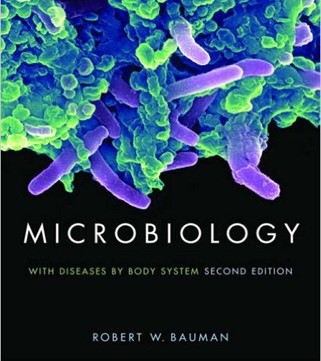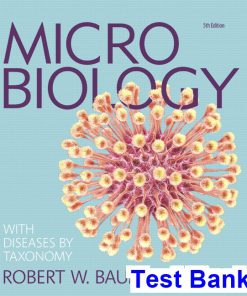Microbiology with Diseases by Body System 2nd Edition Bauman Test Bank
$35.00 Original price was: $35.00.$26.50Current price is: $26.50.
Microbiology with Diseases by Body System 2nd Edition Bauman Test Bank
This is completed downloadable of Microbiology with Diseases by Body System 2nd Edition Bauman Test Bank

Product Details:
- ISBN-10 : 0321513185
- ISBN-13 : 978-0321513182
- Author: Robert W. Bauman Ph.D.
Designed for pre-nursing and allied health students (and also mixed-majors courses), Microbiology with Diseases by Body System, Second Edition retains the hallmark art program and clear writing style that have made Robert Bauman’s book a success. Filled with intriguing content based on cutting-edge research that engages students, the Second Edition features increased clinical coverage as well as a strong focus on the beneficial effects of microbes. Media Manager 2.1 provides instructors with the most robust media program available in the microbiology market for dynamic classroom presentations. In addition to all of the art, photos, and tables from the book in JPEG and PowerPoint® format and customizable PowerPointlecture outlines, Media Manager 2.1 also includes 115 brief Microbiology Animations that depict complex microbial processes. These animations also appear on The Microbiology Place Website, with gradable quizzes, for students.
Table of Content:
1 A Brief History of Microbiology 000 2 The Chemistry of Microbiology 000 3 Cell Structure and Function 000 4 Microscopy, Staining, and Classification 000 5 Microbial Metabolism 000 6 Microbial Nutrition and Growth 000 7 Microbial Genetics 000 8 Recombinant DNA Technology 000 9 Controlling Microbial Growth in the Environment 000 10 Controlling Microbial Growth in the Body: Antimicrobial Drugs 000 11 Characterizing and Classifying Prokaryotes 000 12 Characterizing and Classifying Eukaryotes 000 13 Characterizing and Classifying Viruses, Viroids, and Prions 000 14 Infection, Infectious Diseases, and Epidemiology 000 15 Nonspecific Lines of Defense 000 16 Specific Defense: The Immune Response 000 17 Immunization and Immune Testing 000 18 Hypersensitivities, Autoimmune Diseases, and Immune Deficiencies 000 19 Microbial Diseases of the Skin 000 20 Microbial Diseases of the Nervous System 000 21 Microbial Cardiovascular and Systemic Diseases 000 22 Microbial Diseases of the Respiratory System 000 23 Microbial Diseases of the Digestive System 000 24 Microbial Diseases of the Urinary and Reproductive Systems 000 25 Applied and Environmental Microbiology 000 Appendix A Metabolic Pathways A-1 Appendix B Some Mathematical Considerations in Microbiology B-1 Appendix C Classification of Bacteria According to Bergey's Manual C-1 Appendix D Major Microbial Agents of Disease by Body System Affected D-1 Appendix E Answers to End-of-Chapter Questions for Review E-1 Glossary G-1 Index I-1 CONTENTS CHAPTER 1 A Brief History of Microbiology 000 The Early Years of Microbiology 000 What Does Life Really Look Like? 000 How Can Microbes Be Classified? 000 The Golden Age of Microbiology 000 Is Spontaneous Generation of Microbial Life Possible? 000 What Causes Fermentation? 000 What Causes Disease? 000 How Can We Prevent Infection and Disease? 000 The Modern Age of Microbiology 000 What Are the Basic Chemical Reactions of Life? 000 How Do Genes Work? 000 What Roles Do Microorganisms Play in the Environment? 000 How Do We Defend Against Disease? 000 What Will the Future Hold? 000 Chapter Summary 000 Questions for Review 000 CHAPTER 2 The Chemistry of Microbiology 000 Atoms 000 Atomic Structure 000 Isotopes 000 Electron Configurations 000 Chemical Bonds 000 Nonpolar Covalent Bonds 000 Polar Covalent Bonds 000 Ionic Bonds 000 Hydrogen Bonds 000 Chemical Reactions 000 Synthesis Reactions 000 Decomposition Reactions 000 Exchange Reactions 000 Water, Acids, Bases, and Salts 000 Water 000 Acids and Bases 000 Salts 000 Organic Macromolecules 000 Functional Groups and Monomers 000 Lipids 000 Carbohydrates 000 Proteins 000 Nucleic Acids 000 Chapter Summary 000 Questions for Review 000 CHAPTER 3 Cell Structure and Function 000 Processes of Life 000 Eukaryotic and Prokaryotic Cells: An Overview 000 External Structures of Prokaryotic Cells 000 Glycocalyces 000 Flagella 000 Fimbriae and Pili 000 Prokaryotic Cell Walls 000 Bacterial Cell Walls 000 Archaeal Cell Walls 000 Prokaryotic Cytoplasmic Membranes 000 Structure 000 Function 000 Cytoplasm of Prokaryotes 000 Cytosol 000 Inclusions 000 Nonmembranous Organelles 000 External Structures of Eukaryotic Cells 000 Glycocalyces 000 Flagella 000 Cilia 000 Eukaryotic Cell Walls and Cytoplasmic Membranes 000 Cytoplasm of Eukaryotes 000 Nonmembranous Organelles 000 Membranous Organelles 000 Endosymbiotic Theory 000 Chapter Summary 000 Questions for Review 000 CHAPTER 4 Microscopy, Staining, and Classification 000 Units of Measurement 000 Microscopy 000 General Principles of Microscopy 000 Light Microscopy 000 Electron Microscopy 000 Probe Microscopy 000 Staining 000 Preparing Specimens for Staining 000 Principles of Staining 000 Simple Stains 000 Differential Stains 000 Special Stains 000 Staining for Electron Microscopy 000 Classification and Identification of Microorganisms 000 Linnaeus, Whitaker, and Taxonomic Categories 000 Domains 000 Taxonomic and Identifying Characteristics 000 Taxonomic Keys 000 Chapter Summary 000 Questions for Review 000 CHAPTER 5 Microbial Metabolism 000 Basic Chemical Reactions Underlying Metabolism 000 Catabolism and Anabolism 000 Oxidation and Reduction Reactions 000 ATP Production and Energy Storage 000 The Roles of Enzymes in Metabolism 000 Carbohydrate Catabolism 000 Glycolysis 000 Alternatives to Glycolysis 000 Cellular Respiration 000 Fermentation 000 Other Catabolic Pathways 000 Lipid Catabolism 000 Protein Catabolism 000 Photosynthesis 000 Chemicals and Structures 000 Light-Dependent Reactions 000 Light-Independent Reactions 000 Other Anabolic Pathways 000 Carbohydrate Biosynthesis 000 Lipid Biosynthesis 000 Amino Acid Biosynthesis 000 Nucleotide Biosynthesis 000 Integration and Regulation of Metabolic Functions 000 Chapter Summary 000 Questions for Review 000 CHAPTER 6 Microbial Nutrition and Growth 000 Growth Requirements 000 Nutrients: Chemical and Energy Requirements 000 Physical Requirements 000 Ecological Associations 000 Culturing Microorganisms 000 Clinical Sampling 000 Obtaining Pure Cultures 000 Culture Media 000 Special Culture Techniques 000 Preserving Cultures 000 Growth of Microbial Populations 000 Mathematical Considerations in Population Growth 000 Generation Time 000 Phases of Microbial Growth 000 Measuring Microbial Growth 000 Chapter Summary 000 Questions for Review 000 CHAPTER 7 Microbial Genetics 000 The Structure and Replication of Genomes 000 The Structure of Nucleic Acids 000 The Structure of Prokaryotic Genomes 000 The Structure of Eukaryotic Genomes 000 DNA Replication 000 Gene Function 000 The Relationship Between Genotype and Phenotype 000 The Transfer of Genetic Information 000 The Events in Transcription 000 Translation 000 Control of Transcription 000 Mutations of Genes 000 Types of Mutations 000 Effects of Mutations 000 Mutagens 000 Frequency of Mutation 000 DNA Repair 000 Identifying Mutants, Mutagens, and Carcinogens 000 Genetic Recombination and Transfer 000 Horizontal Gene Transfer Among Prokaryotes 000 Transposons and Transposition 000 Chapter Summary 000 Questions for Review 000 CHAPTER 8 Recombinant DNA Technology 000 The Role of Recombinant DNA Technology in Biotechnology 000 The Tools of Recombinant DNA Technology 000 Mutagens 000 The Use of Reverse Transcriptase to Synthesize cDNA 000 Synthetic Nucleic Acids 000 Restriction Enzymes 000 Vectors 000 Gene Libraries 000 Techniques of Recombinant DNA Technology 000 Multiplying DNA in vitro: The Polymerase Chain Reaction (PCR) 000 Selecting a Clone of Recombinant Cells 000 Separating DNA Molecules: Gel Electrophoresis and the Southern Blot 000 Inserting DNA into Cells 000 Applications of Recombinant DNA Technology 000 Genome Mapping 000 Pharmaceutical and Therapeutic Applications 000 Agricultural Applications 000 The Ethics and Safety of Recombinant DNA Technology 000 Chapter Summary 000 Questions for Review 000 CHAPTER 9 Controlling Microbial Growth in the Environment 000 Basic Principles of Microbial Control 000 Terminology of Microbial Control 000 Microbial Death Rates 000 Action of Antimicrobial Agents 000 The Selection of Microbial Control Methods 000 Factors Affecting the Efficacy of Antimicrobial Methods 000 Methods for Evaluating Disinfectants and Antiseptics 000 Physical Methods of Microbial Control 000 Heat-Related Methods 000 Refrigeration and Freezing 000 Desiccation and Lyophilization 000 Filtration 000 Osmotic Pressure 000 Radiation 000 Chemical Methods of Microbial Control 000 Phenol and Phenolics 000 Alcohols 000 Halogens 000 Oxidizing Agents 000 Surfactants 000 Heavy Metals 000 Aldehydes 000 Gaseous Agents 000 Antimicrobials 000 Development of Resistant Microbes 000 Chapter Summary 000 Questions for Review 000 CHAPTER 10 Controlling Microbial Growth in the Body: Antimicrobial Drugs 000 The History of Antimicrobial Agents 000 Mechanisms of Antimicrobial Action 000 Inhibition of Cell Wall Synthesis 000 Inhibition of Protein Synthesis 000 Disruption of Cytoplasmic Membranes 000 Inhibition of Metabolic Pathways 000 Inhibition of Nucleic Acid Synthesis 000 Prevention of Virus Attachment 000 Clinical Considerations in Prescribing Antimicrobial Drugs 000 Spectrum of Action 000 Efficacy 000 Routes of Administration 000 Safety and Side Effects 000 Resistance to Antimicrobial Drugs 000 The Development of Resistance in Populations 000 Mechanisms of Resistance 000 Multiple Resistance and Cross Resistance 000 Retarding Resistance 000 Chapter Summary 000 Questions for Review 000 CHAPTER 11 Characterizing and Classifying Prokaryotes 000 General Characteristics of Prokaryotic Organisms 000 Morphology of Prokaryotic Cells 000 Reproduction of Prokaryotic Cells 000 Arrangements of Prokaryotic Cells 000 Endospores 000 Modern Prokaryotic Classification 000 Survey of Archaea 000 Extremophiles 000 Methanogens 000 Survey of Bacteria 000 Deeply Branching and Phototrophic Bacteria 000 Low G + C Gram-Positive Bacteria 000 High G + C Gram-Positive Bacteria 000 Gram-Negative Proteobacteria 000 Other Gram-Negative Bacteria 000 Chapter Summary 000 Questions for Review 000 CHAPTER 12 Characterizing and Classifying Eukaryotes 000 General Characteristics of Eukaryotic Organisms 000 Reproduction in Eukaryotes 000 The Classification of Eukaryotic Organisms 000 Protozoa 000 Distribution of Protozoa 000 Morphology of Protozoa 000 Nutrition of Protozoa 000 Reproduction in Protozoa 000 Classification of Protozoa 000 Fungi 000 The Significance of Fungi 000 Morphology of Fungi 000 Nutrition of Fungi 000 Reproduction in Fungi 000 Classification of Fungi 000 Lichens 000 Algae 000 Distribution of Algae 000 Morphology of Algae 000 Reproduction in Algae 000 Classification of Algae 000 Water Molds and Slime Molds 000 Water Molds 000 Slime Molds 000 Other Eukaryotes of Microbiological Interest: Parasitic Helminths and Vectors 000 Arachnids 000 Insects 000 Chapter Summary 000 Questions for Review 000 CHAPTER 13 Characterizing and Classifying Viruses, Viroids, and Prions 000 Characteristics of Viruses 000 Genetic Material of Viruses 000 Hosts of Viruses 000 Sizes of Viruses 000 Capsid Morphology 000 Viral Shapes 000 The Viral Envelope 000 Classification of Viruses 000 Viral Replication 000 Lytic Replication of Bacteriophages 000 Lysogeny 000 Replication of Animal Viruses 000 The Role of Viruses in Cancer 000 Culturing Viruses in the Laboratory 000 Culturing Viruses in Whole Organisms 000 Culturing Viruses in Embryonated Chicken Eggs 000 Culturing Viruses in Cell (Tissue) Culture 000 Other Parasitic Particles: Viroids and Prions 000 Characteristics of Viroids 000 Characteristics of Prions 000 Are Viruses Alive? 000 Chapter Summary 000 Questions for Review 000 CHAPTER 14 Infection, Infectious Diseases, and Epidemiology 000 Symbiotic Relationships Between Microbes and Their Hosts 000 Types of Symbiosis 000 Normal Microbiota in Hosts 000 How Normal Microbiota Become Opportunistic Pathogens 000 The Movement of Microbes into Hosts: Infection 000 Exposure to Microbes: Contamination and Infection 000 Portals of Entry 000 The Role of Adhesion in Infection 000 The Nature of Infectious Disease 000 Manifestations of Disease: Symptoms, Signs, and Syndromes 000 Causation of Disease: Etiology 000 Virulence Factors of Infectious Agents 000 The Stages of Infectious Diseases 000 The Movement of Pathogens Out of Hosts: Portals of Exit 000 Sources of Infectious Diseases in Humans 000 Animal Reservoirs 000 Human Carriers 000 Nonliving Reservoirs 000 Modes of Infectious Disease Transmission 000 Contact Transmission 000 Vehicle Transmission 000 Vector Transmission 000 Classification of Infectious Diseases 000 Epidemiology of Infectious Diseases 000 Frequency of Disease 000 Epidemiological Studies 000 Hospital Epidemiology: Nosocomial Infections 000 Epidemiology and Public Health 000 Chapter Summary 000 Questions for Review 000 CHAPTER 15 Nonspecific Lines of Defense 000 An Overview of the Body's Defenses 000 The Body's First Line of Defense 000 The Role of Skin in Nonspecific Defense 000 The Role of Mucous Membranes in Nonspecific Defense 000 The Role of Normal Microbiota in Nonspecific Defense 000 Other First-Line Defenses 000 An Overview of the Body's Second Line of Defense 000 Defense Components of Blood 000 The Body's Second Line of Defense 000 Phagocytosis 000 Extracellular Killing by Leukocytes 000 Nonspecific Chemical Defenses Against Pathogens 000 Inflammation 000 Fever 000 Chapter Summary 000 Questions for Review 000 CHAPTER 16 Specific Defense: The Immune Response 000 Elements of Specific Immunity 000 Antigens 000 The Cells, Tissues, and Organs of the Lymphatic System 000 B Lymphocytes (B Cells) and Antibodies 000 T Lymphocytes (T Cells) 000 Immune System Cytokines 000 The Body's Preparation for a Specific Immune Response 000 Lymphocyte Editing by Clonal Deletion 000 The Roles of the Major Histocompatibility Complex 000 Antigen Processing 000 The Humoral Immune Response 000 B Cell Activation and Clonal Selection 000 Memory B Cells and the Establishment of Immunological Memory 000 The Cell-Mediated Immune Response 000 The Perforin-Granzyme Cytotoxic Pathway 000 The CD95 Cytotoxic Pathway 000 Memory T Cells 000 T Cell Regulation 000 Types of Acquired Immunity 000 Naturally Acquired Active Immunity 000 Naturally Acquired Passive Immunity 000 Artificially Acquired Active Immunity 000 Artificially Acquired Passive Immunity 000 Chapter Summary 000 Questions for Review 000 CHAPTER 17 Immunization and Immune Testing 000 Immunization 000 Brief History of Immunization 000 Active Immunization 000 Passive Immunization 000 Immune Testing 000 Precipitation Tests 000 Agglutination Tests 000 Neutralization Tests 000 The Complement Fixation Test 000 Labeled Antibody Tests 000 Recent Developments in Immune Testing 000 Chapter Summary 000 Questions for Review 000 CHAPTER 18 Hypersensitivities, Autoimmune Diseases, and Immune Deficiencies 000 Hypersensitivities 000 Type I (Immediate) Hypersensitivity 000 Type II (Cytotoxic) Hypersensitivity 000 Type III (Immune Complex-Mediated) Hypersensitivity 000 Type IV (Delayed or Cell-Mediated) Hypersensitivity 000 Autoimmune Diseases 000 Causes of Autoimmune Diseases 000 Single-Tissue Autoimmune Diseases 000 Systemic Autoimmune Diseases 000 Immunodeficiency Diseases 000 Primary Immunodeficiency Diseases 000 Acquired Immunodeficiency Diseases 000 Chapter Summary 000 Questions for Review 000 CHAPTER 19 Microbial Diseases of the Skin 000 Structure of the Skin 000 Normal Microbiota of the Skin 000 Bacterial Diseases of the Skin 000 Folliculitis 000 Staphylococcal Scalded Skin Syndrome 000 Impetigo (Pyoderma) and Erysipelas 000 Necrotizing Fasciitis 000 Acne 000 Cat Scratch Disease 000 Pseudomonas Infection 000 Rocky Mountain Spotted Fever 000 Cutaneous Anthrax 000 Viral Diseases of the Skin 000 Diseases of Poxviruses 000 Herpes Infections 000 Warts 000 Chickenpox and Shingles 000 Rubella 000 Measles (Rubeola) 000 Other Viral Rashes 000 Mycoses of the Hair, Nails, and Skin 000 Superficial Mycoses 000 Cutaneous and Subcutaneous Mycoses 000 Parasitic Infestations of the Skin 000 Leishmaniasis 000 Scabies 000 Chapter Summary 000 Questions for Review 000 CHAPTER 20 Microbial Diseases of the Nervous System 000 Structure of the Nervous System 000 Structures of the Central Nervous System 000 Structures of the Peripheral Nervous System 000 Cells of the Nervous System 000 Portals of Infection of the Central Nervous System 000 Bacterial Diseases of the Nervous System 000 Bacterial Meningitis 000 Hansen's Disease (Leprosy) 000 Botulism 000 Tetanus 000 Viral Diseases of the Nervous System 000 Viral Meningitis 000 Poliomyelitis 000 Rabies 000 Arboviral Encephalitis 000 Mycoses of the Nervous System 000 Cryptococcal Meningitis 000 Protozoan Diseases of the Nervous System 000 African Sleeping Sickness 000 Primary Amoebic Meningoencephalopathy 000 Prion Disease 000 Variant Creutzfeldt-Jakob Disease (vCJD) 000 Microbial Diseases of the Eyes 000 Structure of the Eye 000 Trachoma 000 Other Microbial Diseases of the Eyes 000 Chapter Summary 000 Questions for Review 000 CHAPTER 21 Microbial Cardiovascular and Systemic Diseases 000 Structures of the Cardiovascular System 000 Structure of the Heart 000 Movement of Blood and Lymph 000 Bacterial Cardiovascular and Systemic Diseases 000 Septicemia, Bacteremia, and Toxemia 000 Endocarditis 000 Gas Gangrene 000 Brucellosis 000 Tularemia 000 Plague 000 Lyme Disease 000 Viral Cardiovascular and Systemic Diseases 000 Infectious Mononucleosis 000 Cytomegalovirus Disease 000 Yellow Fever 000 Dengue Fever and Dengue Hemorrhagic Fever 000 African Viral Hemorrhagic Fevers 000 Protozoan and Helminthic Cardiovascular and Systemic Diseases 000 Malaria 000 Toxoplasmosis 000 Chagas' Disease 000 Schistosomiasis 000 Chapter Summary 000 Questions for Review 000 CHAPTER 22 Microbial Diseases of the Respiratory System 000 Structures of the Respiratory System 000 Structure of the Upper Respiratory System, Sinuses, and Ears 000 Structures of the Lower Respiratory System 000 Normal Microbiota of the Respiratory System 000 Bacterial Diseases of the Upper Respiratory System, Sinuses, and Ears 000 Streptococcal Respiratory Diseases 000 Diphtheria 000 Sinusitis and Otitis Media 000 Viral Diseases of the Upper Respiratory System 000 Common Cold 000 Bacterial Diseases of the Lower Respiratory System 000 Bacterial Pneumonias 000 Legionellosis (Legionnaire's Disease) 000 Tuberculosis 000 Pertussis (Whooping Cough) 000 Inhalational Anthrax 000 Viral Diseases of the Lower Respiratory System 000 Influenza 000 Severe Acute Respiratory Syndrome (SARS) 000 Respiratory Syncytial Virus Infection 000 Hantavirus Pulmonary Syndrome (HPS) 000 Other Viral Respiratory Diseases 000 Mycoses of the Lower Respiratory System 000 Coccidioidomycosis 000 Blastomycosis 000 Histoplasmosis 000 Pneumocystis Pneumonia (PCP) 000 Chapter Summary 000 Questions for Review 000 CHAPTER 23 Microbial Diseases of the Digestive System 000 Structures of the Digestive System 000 The Gastrointestinal Tract 000 The Accessory Digestive Organs 000 Normal Microbiota of the Digestive System 000 Bacterial Diseases of the Digestive System 000 Dental Caries, Gingivitis, and Periodontal Disease 000 Peptic Ulcers 000 Bacterial Gastroenteritis 000 Bacterial Food Poisoning (Intoxication) 000 Viral Diseases of the Digestive System 000 Oral Herpes 000 Mumps 000 Viral Gastroenteritis 000 Viral Hepatitis 000 Protozoan Diseases of the Intestinal Tract 000 Giardiasis 000 Cryptosporidiosis 000 Amebiasis 000 Helminthic Infestations of the Intestinal Tract 000 Tapeworm Infestations 000 Pinworm Infestations 000 Chapter Summary 000 Questions for Review 000 CHAPTER 24 Microbial Diseases of the Urinary and Reproductive Systems 000 Structures of the Urinary and Reproductive Systems 000 Structures of the Urinary System 000 Structures of the Reproductive Systems 000 Normal Microbiota of the Urinary and Reproductive Systems 000 Bacterial Diseases of the Urinary System 000 Bacterial Urinary Tract Infections 000 Leptospirosis 000 Streptococcal Acute Glomerulonephritis 000 Nonvenereal Diseases of the Reproductive Systems 000 Staphylococcal Toxic Shock Syndrome 000 Bacterial Vaginosis 000 Candidiasis 000 Sexually Transmitted Diseases (STDs) 000 Bacterial STDs 000 Gonorrhea 000 Syphilis 000 Chlamydial Infections 000 Chancroid 000 Viral STDs 000 Genital Herpes 000 Genital Warts 000 Protozoan STD 000 Trichomoniasis 000 Chapter Summary 000 Questions for Review 000 CHAPTER 25 Applied and Environmental Microbiology 000 Food Microbiology 000 The Roles of Microorganisms in Food Production 000 The Causes and Prevention of Food Spoilage 000 Food-Borne Illnesses 000 Industrial Microbiology 000 The Roles of Microbes in Industrial Fermentations 000 Industrial Products of Microorganisms 000 Water and Wastewater Treatment 000 Bioremediation 000 The Problem of Acid Mine Drainage 000 Environmental Microbiology 000 Microbial Ecology 000 The Roles of Microorganisms in Biogeochemical Cycles 000 Soil Microbiology 000 Aquatic Microbiology 000 Biological Warfare and Bioterrorism 000 Assessing Microorganisms as Potential Agents of Warfare or Terror 000 Known Microbial Threats 000 Defense Against Bioterrorism 000 The Roles of Recombinant Genetic Technology in Bioterrorism 000 Chapter Summary 000 Questions for Review 000 BOXES New Frontiers 1.1 Bioterrorism 000 3.1 Understanding Biofilms 000 4.1 "Smart" Bandages of the Future 000 5.1 Gold-Mining Microbes 000 6.1 Is There Life on Other Planets? 000 6.2 Biofilms, Quorum Sensing, and Disease Prevention 000 7.1 Controlling Disease by Controlling Gene Expression 000 8.1 Building a Better Mosquito 000 8.2 Using the Human Genome to Detect Disease-Causing Microbes 000 8.3 Vaccines on the Menu 000 10.1 The AIDS "Cocktail" and the Problem of Drug Resistance 000 11.1 Lactobacillus: A Probiotic to Watch 000 12.1 Amoeba Midwives 000 13.1 High-Pressure Viruses 000 16.1 Attacking Cancer with Lab-Grown T Cells 000 17.1 Listening for Pathogens 000 18.1 Can Pets Help Decrease Children's Allergy Risks? 000 18.2 When Kissing Triggers Allergic Reactions 000 20.1 New Diseases from the Wild 000 21.1 The "Germ Theory" of Heart Disease 000 23.1 In Search of a Malaria Vaccine 000 24.1 The Importance of Adenoviruses in Research 000 25.1 West Nile Virus and Severe Acute Respiratory Syndrome (SARS) 000 25.2 Nipah Virus: From Pigs to Humans 000 26.1 Making Blue Jeans "Green" 000 26.2 Bacterial Batteries 000 26.3 Could Bioterrorists Manufacture Viruses from Scratch? 000 Highlights 2.1 Raw Oysters and Antacids: a Deadly Mix? 000 2.2 Why Can't We Digest Wood? 000 3.1 Are Viruses Alive? 000 3.2 Unusual Giants 000 4.1 "One of the Most Important Inventions of the Century" 000 4.2 Woese's Taxonomic Revolution 000 5.1 Glowing Bacteria 000 5.2 What's that Fishy Smell? 000 6.1 Some Like it Hot: Extreme Thermophiles 000 7.1 Understanding the Central Dogma: It's (No Longer) Greek to Me 000 8.1 Does Genetically Modified Corn Harm Monarch Butterflies? 000 9.1 Odwalla's Road to Pasteurization 000 9.2 Sushi: A Case Study in Microbial Control 000 9.3 Should You Use Antimicrobial Soaps? 000 10.1 Why Do Microbes Make Antibiotics? 000 10.2 Ciprofloxacin and Anthrax 000 11.1 Botulinum Toxin: A Killer and a Healer 000 12.1 Truffles: The Gourmet Fungi 000 13.1 Prescription Bacteriophages? 000 13.2 Kuru and Cannibalism in the Fore Tribe of Papua New Guinea 000 14.1 A Tale of Two Organisms 000 15.1 What Happens to All That Skin? 000 15.2 The Discovery of Phagocytes 000 15.3 The Fight for Iron 000 16.1 The Loss of Helper T Cells in AIDS Patients 000 17.1 Why Isn't There a Cold Vaccine? 000 17.2 Smallpox: To Vaccinate or Not to Vaccinate? 000 18.1 SCID: "Bubble Boy" Disease 000 20.1 The Tale of "Typhoid Mary" 000 22.1 Does "Killer Mold" Exist? 000 24.1 The "Gift" of Smallpox: Bioterrorism During the French and Indian War 000 24.2 Reye's Syndrome: Can Aspirin Harm Children with Viral Diseases? 000 25.1 Rabies: A Threat from the Wild 000 26.1 Oil-Eating Bacteria to the Rescue 000 Case Studies 14.1 A Deadly Carrier 000 14.2 Unusual Transmission of West Nile Virus 000 14.3 Legionella in the Produce Aisle 000 15.1 Evaluating a Complete Blood and Differential Leukocyte Count (CBC) Profile 000 18.1 A Case of AIDS 000 19.1 A Painful Rash 000 19.2 A Sick Soldier 000 20.1 The Man with No Feelings 000 20.2 A Very Sick Sophomore 000 21.1 Blame It on the Chiggers? 000 21.2 Campylobacter and the Lactovegetarians 000 22.1 What's Ailing the Bird Enthusiast? 000 22.2 Is it Athlete's Foot? 000 23.1 Bloody Diarrhea 000 23.2 Painful Dysentery 000 24.1 A Sick Mother-to-Be 000 24.2 A Case of Genital Sores 000 25.1 A Case of AIDS 000 Disease at a Glance 19.1 Rocky Mountain Spotted Fever 000 19.2 Cutaneous Anthrax 000 19.3 Smallpox 000 19.4 Herpes 000 19.5 Chickenpox and Shingles 000 19.6 Rubella 000 19.7 Measles 000 20.1 Listeriosis 000 20.2 Infant Botulism 000 20.3 Tetanus 000 20.4 Rabies 000 20.5 West Nile Encephalitis 000 20.6 Fungal Meningitis (Cryptococcosis) 000 20.7 Variant Creutzfeldt-Jakob Disease (vCJD) 000 23.1 Peptic Ulcers 000 23.2 Cholera 000 23.3 Bacterial Diarrhea 000 23.4 Typhoid Fever and Salmonellosis 000 23.5 Staphylococcal Intoxication (Food Poisoning) 000 23.6 Mumps 000 23.7 Hepatitis 000 23.8 Giardiasis 000 23.9 Amebiasis 000 24.1 Leptospirosis 000 24.2 Toxic Shock Syndrome 000 24.3 Candidiasis 000 24.4 Pelvic Inflammatory Disease (PID) 000 24.5 Gonorrhea 000 24.6 Syphilis 000 24.7 Genital Warts 000
People Also Search:
microbiology with diseases by body system 2nd edition bauman
microbiology with diseases by body system 2nd edition bauman download scribd
microbiology with diseases by body system 2nd edition bauman test bank download pdf












